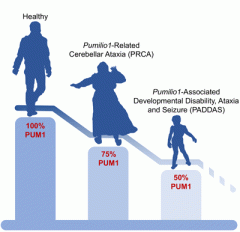Topics
Changes in Pumilio1 levels linked to distinct neurological disorders
In a collaborative study published in Cell, mutations that alter the protein levels of PUMILIO1 (PUM1) can cause a variety of neurological symptoms ranging from mild adult-onset ataxia to childhood-onset ataxia, intellectual disability, developmental delay and seizures. This is the first study to uncover a role for PUM1 in human brain function and to implicate it in two novel neurological syndromes.

The study was conducted in the laboratory of Dr. Huda Zoghbi, professor at Baylor College of Medicine and director of the Jan and Dan Duncan Neurological Research Institute. The lead and co-corresponding author of the study, Dr. Vincenzo Alessandro Gennarino, a former postdoctoral fellow in the Zoghbi lab was recently appointed as an assistant professor at Columbia University Medical Center in New York.
A previous study from the Zoghbi lab had shown that PUM1 regulates levels of ATAXIN1 (ATXN1), a protein whose variant can cause spinocerebellar ataxia type 1 (SCA1). Loss of PUM1 in mice caused 50 percent increase in the levels of ATXN1 in neurons, which led to progressive degeneration of neurons and ataxia.
Until this study, however, it was not known if altering PUM1 levels in humans would affect neurological function.
To address this question, researchers combined extensive patient data from Baylor MIRACA labs with the clinical data obtained from their collaborators at Sydney Children’s Hospital, Children’s Hospital of Philadelphia, Care4Rare and Heidelberg University. They screened 52,000 patients who had previously undergone genetic testing at Baylor MIRACA laboratories and additional patients with known copy number variations in PUM1 gene for neurological defects.
Of the 12 patients who had the more severe disease, nine were missing a copy of the Pumilio1 gene, and two had missense mutations that reduced the stability of the protein so that they had, in effect, only half the normal levels. All these patients suffered a wide range of symptoms, including motor and language delay, small stature, motor incoordination, and seizures that presented typically between 5 months and 1 year of age. The researchers named this condition, “Pumilio1-Associated Developmental Disability, Ataxia and Seizures (PADDAS)”.
The other group of patients, who happened to be members of the same family, had only a partial loss of function in one copy of Pumilio1, resulting in a modest (25 percent) reduction in PUM1 protein levels. These patients developed mild progressive ataxia in late adulthood, in their 40s or 50s. The researchers termed this condition, “Pumilio1-Related Cerebellar Ataxia (PRCA)”.
Thus, the researchers have uncovered a close correlation between modest alterations in PUM1 levels and the age of onset, severity and range of neurological symptoms.
It is well known that neurons are extremely sensitive to large changes in the abundance of a protein. Typically, mutations that lead to modest changes in protein levels are not considered clinically relevant. However, surprising findings from this study show that mutations that cause minor alterations in protein levels could also lead to clinical manifestations and should therefore be further evaluated.
This study not only provides novel insights how PUM1 levels regulate human brain function, but also highlights the importance of investigating the role of other RNA-binding regulatory proteins like PUM1 in neurological and neurodegenerative disorders.





